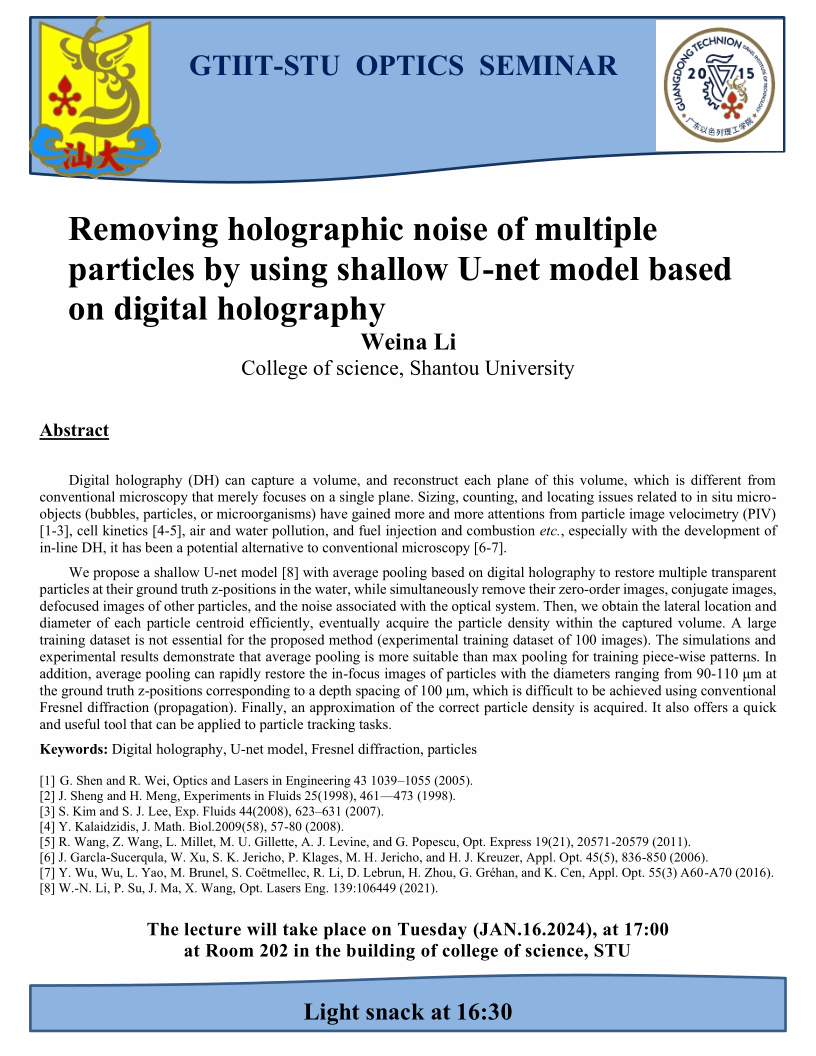STU-GTIIT光学论坛(No.11)
报告题目:Removing holographic noise of multiple particles by using shallow U-net model based on digital holography(全英报告)
报 告 人:Weina Li (College of science, Shantou University)
报告地点:理科楼202(物理系会议室)
报告时间:2024年1月16日 17:00
报告摘要:
Digital holography (DH) can capture a volume, and reconstruct each plane of this volume, which is different from conventional microscopy that merely focuses on a single plane. Sizing, counting, and locating issues related to in situ micro-objects (bubbles, particles, or microorganisms) have gained more and more attentions from particle image velocimetry (PIV) [1-3], cell kinetics [4-5], air and water pollution, and fuel injection and combustion etc., especially with the development of in-line DH, it has been a potential alternative to conventional microscopy [6-7].
We propose a shallow U-net model [8] with average pooling based on digital holography to restore multiple transparent particles at their ground truth z-positions in the water, while simultaneously remove their zero-order images, conjugate images, defocused images of other particles, and the noise associated with the optical system. Then, we obtain the lateral location and diameter of each particle centroid efficiently, eventually acquire the particle density within the captured volume. A large training dataset is not essential for the proposed method (experimental training dataset of 100 images). The simulations and experimental results demonstrate that average pooling is more suitable than max pooling for training piece-wise patterns. In addition, average pooling can rapidly restore the in-focus images of particles with the diameters ranging from 90-110 μm at the ground truth z-positions corresponding to a depth spacing of 100 μm, which is difficult to be achieved using conventional Fresnel diffraction (propagation). Finally, an approximation of the correct particle density is acquired. It also offers a quick and useful tool that can be applied to particle tracking tasks.
Keywords: Digital holography, U-net model, Fresnel diffraction, particles
[1] G. Shen and R. Wei, Optics and Lasers in Engineering 43 1039–1055 (2005).
[2] J. Sheng and H. Meng, Experiments in Fluids 25(1998), 461—473 (1998).
[3] S. Kim and S. J. Lee, Exp. Fluids 44(2008), 623–631 (2007).
[4] Y. Kalaidzidis, J. Math. Biol.2009(58), 57-80 (2008).
[5] R. Wang, Z. Wang, L. Millet, M. U. Gillette, A. J. Levine, and G. Popescu, Opt. Express 19(21), 20571-20579 (2011).
[6] J. Garcla-Sucerqula, W. Xu, S. K. Jericho, P. Klages, M. H. Jericho, and H. J. Kreuzer, Appl. Opt. 45(5), 836-850 (2006).
[7] Y. Wu, Wu, L. Yao, M. Brunel, S. Coëtmellec, R. Li, D. Lebrun, H. Zhou, G. Gréhan, and K. Cen, Appl. Opt. 55(3) A60-A70 (2016).
[8] W.-N. Li, P. Su, J. Ma, X. Wang, Opt. Lasers Eng. 139:106449 (2021).

欢迎全校师生参加!
理学院
2024年1月10日
